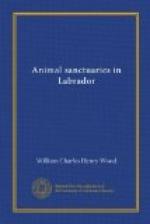Labrador has over 200 species of birds, from humming-birds and sanderlings to eagles, gannets, loons and herons. Among those able to hold their own, with proper encouragement, are the following: two loons, two murres, the puffin, guillemot, razor-billed auk, dovekie and pomarine jaeger; six gulls—ivory, kittiwake, glaucous, great black-back, herring and Bonaparte; two terns—arctic and common; the fulmar, two shearwaters, two cormorants, the red-breasted merganser and the gannet; seven ducks—the black, golden-eye, old squaw and harlequin, with the American, king and Greenland eiders; three scoters; four geese—snow, blue, brant and Canada; two phalaropes, several sandpipers, with the Hudsonian godwit and both yellowlegs; two snipes; five plovers; and the Eskimo and Hudsonian curlews. These two curlews should be absolutely closed to all shooting everywhere for several seasons. They are on the verge of extinction; and it may even now be too late to save them. The great blue heron and American bittern are not common, but less rare than they are supposed to be. Except for the willow and rock ptarmigans the land game-birds are not many in kind or numbers. There are a fair number of ruffed grouse in the south, and more spruce grouse in the north. The birds of prey are well represented by a few golden and more bald-headed eagles, the American rough-legged and other hawks, the black and the white gyrfalcons, the osprey, and eight owls, including the great horned owl, the boldest bird of all. The raven is widely distributed all the year round. Several woodpeckers, kingfishers, jays, bluebird, kingbird, chickadee, snow bunting; several sparrows, including, fortunately, the white-crowned, white-throat and song, but now, unfortunately, the English as well. There are blackbirds, red-polls, a dozen warblers, the American robin, hermit thrush and ruby-throated humming-bird.
Both the land and sea mammals are of great importance. Several whales are well known. The Right is almost exterminated; but the Greenland, or Bow-head, is found along the edge of the ice in all Hudsonian waters. The Pollock is rare, and the Sperm, or Cachalot, as nearly exterminated as the Right. But the Little-piked, or rostrata, is found inshore along the north and east, the Bottle-nose on the north, the Humpback on the east and south; and the Finback and Sulphur-bottom are common and widely distributed, especially on the east. The Little White whale, or “White porpoise,” is fairly common all round; the Killer is widely distributed, but most numerous on the east, where the Narwhal is also found. The Harbour and Striped porpoises, and the Common and Bottle-nosed dolphins, are chiefly on the east and south. There are six Seals—the Harbour, Ringed, Harp, Bearded, Grey and Hooded. The Harbour seal is also called the “Common” and the “Wise” seal, and is the vitulina of zoology. It is common all round the coasts, and the Indians of the interior assert that many live permanently in




